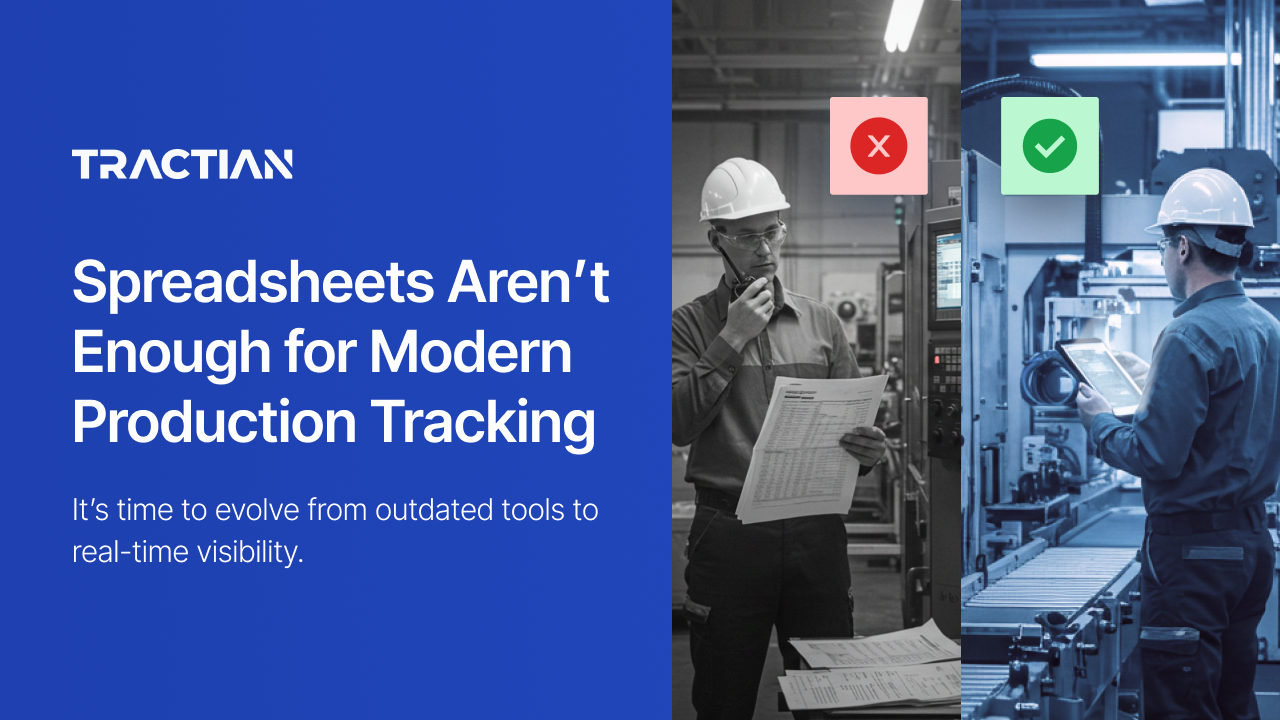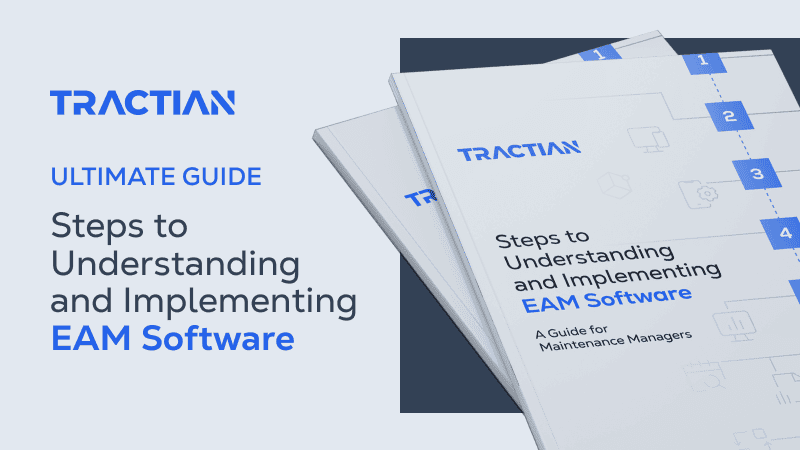It seems like every environment has an automated tool these days. Corporate offices use Slack. Schools run on Canvas. So why are factories stuck in the past? Spreadsheets might feel familiar, but they’re keeping teams stuck by slowing decisions, hiding inefficiencies, and leaving teams reactive instead of proactive.
Real-time insight isn’t a luxury, it’s the standard. To hit your OEE targets and reduce downtime, you need more than data logs. You need a system that works as fast as your line does.
Why Spreadsheets Persist and Where They Fail
Spreadsheets have remained relevant for decades, and there's a good reason why. They’re familiar, flexible, and low cost, which means production managers set them up to log several basic metrics.
Shift, output, machine runtime, defect, and downtime data are easy to input for one or two stations. But what happens when you need to record information from ten machines? Twenty? At scale, the flexibility they once offered turns into fragmented operations.
Manual Logging leads to inconsistent data and delayed insights. Cumbersome data entry that once relied on operators punching in numbers can be delegated to production tracking software, leaving the team to focus on what they do best.
Different Naming Conventions (“stuck” vs. “jammed” vs. “blockage”) break pattern recognition and skew downtime data. Without standardized vocabulary or automated labeling, manual data analysis omits information, leaving you with an incomplete view of your production.
No audit trail makes it hard to maintain version control, trace edits, or enforce accountability over who made what change. This gets in the way of a clear picture of production and prevents your team from being able to track operator success and efficiency on multiple levels.
Limited visibility gets in the way of real-time responses to active issues, which means decision-makers see problems only after they’ve impacted production. Modern platforms not only give you insight into what’s happening now, but can also predict when production delays may happen in the future.
Scalability issues arise when you add lines, shifts, or sites. Consolidating data across multiple spreadsheets leaves too much room for error, and record-keeping turns into a nightmare.
Teams generally only begin to consider upgrading to more modern solutions once output is affected by these issues. But why wait for something to go wrong to consider upgrading systems?
Dedicated production tracking software works with any size operation, and offers accuracy, visibility, and control that manual tools simply can’t match.
Core benefits at a glance
Using a manufacturing performance or production monitoring software (sometimes known as OEE software) provides several clear advantages.
- Real-time visibility: Monitor machine status, output, and line events as they happen. With a shared real-time dashboard and transparent communication across the shop floor, operators, supervisors, and maintenance teams can view the same data and collaborate on improvements instead of working in silos.
- Automated downtime tracking: Every stoppage (planned or unplanned) is captured and categorized. This allows maintenance to respond faster, reducing mean time to repair (MTTR). Some solutions even offer AI pattern detection, allowing teams to reduce mean time between failures (MTBF) by tackling root causes proactively.
- Root cause analytics: Drill into reasons for downtime, frequency, and trends. Measure any metric, set desired thresholds for each one, and determine where problems arise to ensure that your production runs at optimal performance shift after shift.
- Alerts and notifications: Trigger maintenance or checks immediately when systems identify a production delay, and make sure that the right people are alerted at the right time.
- Standardized reporting: Consistent, searchable reports, customizable dashboards, and KPI scorecards. Platforms like Tractian OEE even allow users to create, perform, and store quality checks without ever leaving the platform.
- Continuous improvement support: Identify systemic inefficiencies, prioritize countermeasures, and track the impact of changes across your entire production. Rich data enables root cause analysis, trend spotting (across shifts, machines, or output types), and measuring the impact of corrective actions over time.
The end goal in tracking performance is to boost overall equipment effectiveness (OEE), a composite metric, where OEE = Availability × Performance × Quality.
A production tracking software should directly support all three components by providing live line event alerts, automatic insights into cycle time trends, and a way to digitally create and track quality procedures.
Overall, production monitoring software is the best way to gather insights from the data your machines already provide and suggest preventive fixes to recurring issues to ensure your operation stays on track.
Non-Negotiable Hardware Capabilities for Production Tracking
When evaluating software, you want to make sure you make the best choice for your team.
Easy-install sensors and compatibility with PLC/analog infrastructure facilitates a smooth transition, and circumvents the need for manual entry. The best systems will provide real-time machine data acquisition via PLC-compatible IIoT sensors.
Integration with CMMS / ERP / MES is what will give you full visibility into all production insights. Linking performance data with maintenance workflows and enterprise systems maximizes value and ensures you don’t miss a single line event, and can request a fix as soon as a slowdown occurs.
Scalability and multi-site support is a given. The software and accompanying sensors should be able to accommodate expanding lines, plants, and data volume extra hassle.
Solutions like Tractian OEE™ offer secure, universally-compatible sensors, full integration with existing CMMS systems, and on-site white-glove support to assist from install to scale-up.
Transitioning from Spreadsheets to Full Software
Shifting from spreadsheets to automated software might seem complex, but the path is well mapped, and it’s important to note that it doesn’t have to happen overnight. Many manufacturers have already made this transition using proven frameworks for moving from manual to hybrid to fully digital production tracking.
Step 1: Define clear objectives and metrics
Start with a clear vision to define measurable, long-term goals. Use these metrics to guide system configuration and success measurement.
What’s your current baseline OEE?
What is your short-term and long-term target (e.g. raise OEE by 10% in 6 months)?
Which machines or production lines are the highest priority?
What is an acceptable downtime threshold per shift?
How much time can be allotted for idle periods like setup, material inspection, and shift transitions?
With actionable goals, implementing a production tracking software becomes a way to reach those milestones, not just another administrative task to check off.
Step 2: Map your processes and downtime taxonomy
Before importing anything into software, standardize your downtime reason codes, machine states, and workflows. Document definitions like what constitutes “unplanned vibration fault,” “operator delay,” “raw material shortage,” and categorize by planned downtime, changeover, micro stops, equipment fault, or quality reject stoppage.
This taxonomy ensures consistency and meaningful reporting once software is live, and makes the transition to automated line event labeling easier.
Step 3: Pilot with one line or station
Begin with a pilot deployment on a high-impact but manageable line. You can use that period to validate hardware connectivity, ensure data quality meets expectations, test real-time dashboards under real conditions, and train operators and maintenance personnel for smooth adoption. It also allows you to refine configurations before scaling to additional lines or sites.
Step 4: Integrate with your CMMS, ERP, or MES
To maximize value, connect your production monitoring solution to a CMMS and other existing software. This integration creates a transparent, automated workflow that generates work orders, syncs production and performance data, and centralizes KPI reporting in one interface. With Tractian, this level of integration, automation, and visibility comes built-in.
Step 5: Train users and embed culture change
The transition from manual to automated shouldn’t be something management forces on operators. The value in monitoring manufacturing processes starts with the people on the shop floor every day; it simplifies reporting processes, downtime and idle time labeling, and cross-facility communication.
If the benefits of making the switch aren’t immediately apparent to everyday platform users, you need to reconsider your software choice. Some ways to encourage adoption include training operators, supervisors, and maintenance staff on the quality of life features in the platform, like tagging downtime reasons, setting up automated quality checks, and chatting across the plant right from the platform using a feature like FactoryChat from Tractian OEE™.
Step 6: Iterate and improve continuously
Once deployed, the system becomes a tool for continuous improvement. Use downtime reports and OEE trends to identify and address recurring minor (e.g. frequent small stops, changeover inefficiencies), launch kaizen or root cause improvement efforts (e.g. SMED, TPM) targeted at the top losses, and track the impact of changes via dashboards and auto-generated reports.
Because the software captures data continuously, you can adjust configurations, thresholds, or workflows as new insights emerge and course correct more dynamically than with spreadsheets.
A Comparative Example: Spreadsheet vs. Downtime Tracking Software
| Feature | Spreadsheet-based Tracking | Dedicated OEE Software |
|---|---|---|
| Event Labeling | Manual, end-of-shift, or at delay | Real-time, automatic, or one-click operator input |
| Micro-stop categorization | Often missed or labeled as "other" | Captured and categorized precisely |
| Reporting latency | Hours or days | Instant dashboards and alerts |
| Consistency and taxonomy | High variation in code reasons | Standardized reason codes and enforced taxonomy |
| Root cause analysis | Time-intensive and error-prone | Built-in analytics, trend views, AI powered analysis |
| Alerts & notifications | None or manual | Alerts sent automatically to the right people at the right time |
| Integration with maintenance | Manual crossover | Tight integration with condition monitoring and CMMS |
| Scalability | Cumbersome growth | Scales across machines, lines, and sites |
| Continuous improvement support | Limited by lag and manual effort | Enables ongoing, data-drive, kaizen cycles |
Introducing Tractian OEE™ as a Solution
For manufacturers exploring OEE and downtime tracking software options, Tractian OEE is an all-in-one solution. It is part of a broader ecosystem of monitoring and maintenance solutions offered, and integrates seamlessly with your existing infrastructure (made possible through PLC/analog compatible clip-on sensors that are certifiably secure) to deliver a clear view into your production.
What is Tractian OEE?
Tractian OEE is a production monitoring software that transforms machine and operational data into actionable insights. It also provides the opportunity to integrate production tracking with CMMS and condition-based monitoring platforms, offering holistic production and reliability analytics. When all three solutions work together, alerts or events in one domain can trigger actions in the others.
Tractian OEE allows you to monitor your OEE in real time, visualize machine data, identify downtime causes, and discover hidden inefficiencies, all in a single platform.
Fully Integrated, Fully Visible: Tractian OEE offers live machine status, alerts for downtime, idle time, and even reduced speed, and best-in-class AI analyses of inefficiencies. Because it integrates seamlessly with the other solutions Tractian offers for condition monitoring, and asset management and work orders, you avoid data silos.
Scalability & Ease of Use: Whether you’re monitoring one line or multiple sites, the architecture supports expansion across your operations. Tractian supports fast installation with secure, easy-to-install sensors and universal compatibility across both existing systems and equipment.
AI and diagnostics features: Tractian OEE integrates AI-powered diagnostics with real-time monitoring to detect anomalies and production inefficiencies the moment they occur. Its contextual intelligence engine doesn’t just flag issues, it understands behavior patterns, enabling predictive actions that account for idle time and prevent failures before they impact throughput. Technicians and reliability teams get instant alerts and clear next steps, transforming reactive action into a strategic advantage.
Hardware Compatibility: Tractian’s edge comes from its seamless hardware integration. Our sensors like the Uni Trac and Energy Trac were designed from the ground up to talk natively with the OEE platform. All signals feed directly into a unified system, enabling fast deployment and real-time analysis without retrofitting or complex setups. This compatibility not only reduces onboarding friction but also future-proofs your plant’s digital transformation.
Because Tractian OEE sits at the intersection of production tracking and maintenance, it supports a shift from reactive downtime recovery to proactive reliability management.
Transitioning from spreadsheet-based production tracking to dedicated downtime tracking software and OEE monitoring software is a journey, one that yields powerful rewards.
Solutions like Tractian OEE illustrate how a unified platform can connect production monitoring with maintenance reliability. By starting small, defining clear goals, integrating systems, and inculcating continuous improvement habits, manufacturers can evolve from reactive firefighting to proactive performance optimization.
If you’re considering moving beyond spreadsheets, take this as your sign to begin; the data, insights, and performance improvements speak for themselves. To see how Tractian can help you maximize your ROI with an integrated approach to production monitoring, book your free demo today.


